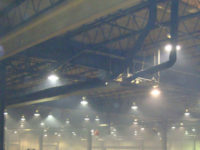The act of joining together two different pieces of metal is nothing new. Over the past few centuries, however, new industrial techniques have yielded a variety of different types of welding that can create stronger bonds and expand the kinds of material that can be joined together.
At a glance, the topic may seem straightforward — but the welding method used can have a serious impact on the quality of bond created.
Below, we'll cover the different types of welding, how they're distinct from each other and the situations where each is typically used.
Stick welding
Stick welding, or shielded arc metal welding) is the oldest and most-efficient form of metal arc welding available. With this method, a flux-coated length of wire, called an electrode, is fed through a welding gun. As it moves, this electrode causes the gun to spark, melting both the metal workpiece and the electrode. This process creates a pool of molten metal, called a weld pool, which cools to form the weld.
Stick welding is the simplest form of welding and is easy for beginners and hobbyists to pick up.
The weld created by stick welding, however, is rarely neat. Exposure to atmospheric gases can cause the weld to be bubbly or porous, requiring some sanding and cleaning once the weld has cooled.
Metal inert gas (MIG)
MIG welding is very similar to stick welding. However, MIG welding also sends a shielding gas through the welding gun, along with the electrode. This gas — typically argon, helium, carbon dioxide or oxygen — is sent through the gun to prevent the weld from being exposed to atmospheric gases. As a result, an MIG weld is often less irregular than one created by stick welding.
Tungsten inert gas (TIG)
TIG welding is similar to MIG welding but uses a fixed tungsten electrode instead of a solid wire electrode. The tungsten does not melt during the welding process.
Flux-cored welding (FCW)
Flux-cored welding is like MIG, TIG and stick welding, but does not use gas and swaps out the wire electrode for a flux-cored wire. The flux in the electrode shields the arc from contamination from outside gases, resulting in a weld similar to those produced by MIG or TIG welding, without the need for an inert gas.
Laser welding
As you might guess from the name, laser welding uses laser beams to join two pieces of metal or thermoplastic. The heat provided by the laser beam melts an area on both objects, quickly creating a melt pool that is both deep and narrow. While it's possible to laser weld by hand, most laser welding is performed by automated systems in large-scale industrial manufacturing processes.
Electron-beam welding (EBW)
Electron-beam welding is a welding process that uses a beam of high-velocity electrons to weld together two different parts. The energy of the electrons striking the work pieces causes them to melt and flow together, creating a weld.
This method requires specialized equipment — typically an electron gun and a working vacuum chamber. As with laser welding, most electron-beam welding is performed by automated systems1 that control the direction of the electron gun and the flow of the electron beam.
Atomic hydrogen welding (AHW)
AHW uses an arc generated by a pair of tungsten electrodes within a hydrogen atmosphere to create a weld. This method of welding has mostly been replaced by TIG but is still used in some instances due to some of the unique advantages2 it can provide.
Friction welding
With friction welding, two objects — often made out of metal, but also materials like plastic, or even wood3 — are joined under pressure by the use of friction. The objects are rubbed together, and the heat and pressure work together to create a bond.
Radio-frequency welding (RFW)
Radio-frequency welding is commonly used to join together thermoplastics4 when other joining methods — like solvents or fasteners — aren't appropriate.
With this technique, high-frequency electromagnetic energy is used to induce heating and create a bond between two pieces of plastic.
Hot gas welding
This is another welding technique that is primarily used to join together plastics. With this type of welding, a hot air gun is used to direct a jet of hot air that heats and softens both the parts to be joined, as well as a plastic filler rod. This filler rod acts similarly to the electrode in stick welding, moving through the hot air gun and melting at the tip, joining together with the softened plastic of the parts to create a weld.
Uses of different welding types
If you need to join together two different parts, you have a variety of welding types to choose from. Less complex welding types — like MIG, TIG and stick welding — will be a good fit for manufacturing at most scales and is easy for amateurs or hobbyists to pick up. More advanced welding types — like laser welding, friction welding and RF welding — also have their uses, but often require specialized equipment and skilled workers.
Sources:
- https://www.techbriefs.com/component/content/article/tb/supplements/ptb/features/articles/9998
- https://www.theweldingmaster.com/atomic-hydrogen-welding/
- https://www.youtube.com/watch?v=X0k04hjdYuQ
- https://markperi.com/industries-use-radio-frequency-welding/pharmaceutical/



